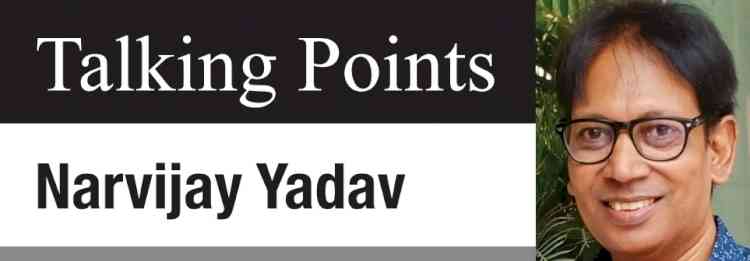The world sits on a population bomb
The world population is currently touching the figure of 8 billion. Looking at the speed with which the human population is increasing in various countries of the world, it is estimated that by the year 2050, the total human population on the earth will reach 10 billion or more.

The world population is currently touching the figure of 8 billion. Looking at the speed with which the human population is increasing in various countries of the world, it is estimated that by the year 2050, the total human population on the earth will reach 10 billion or more. This is a very huge number, which is posing a danger in terms of food supply and other day-to-day necessities of the people. The burden of the human population on the earth is increasing every passing year, while humans are destroying other creatures and trees for their greed and to make their life comfortable. The life of all living beings in nature is dependent on each other. This makes an ecosystem. The bio-balance of the earth is disturbed when the number of any of these organisms or vegetation increases or decreases out of proportion. As a result, all kinds of natural calamities and problems arise. Man is increasing his population, and is bent on destroying trees, vegetation, insects, birds, animals, and wildlife in different ways. This is a matter of great concern. Problems are arising due to this reason not only in one country but in all the countries of the world. In terms of population, China ranks first in the world, India is second, and America is in third place.
As the population increases, facilities like education, health, and housing decline. The crisis of the availability of fuel to food arises in front of the world. Due to the increasing population, problems related to the environment, food supply, water shortage, energy crunch, unemployment, etc. arise in all the countries of the world. As the population increases, the standard of living falls and problems creep in. About 17 percent of the world's population lives in India, where illiteracy is the main reason for population growth.
About 50 percent of the world's population (8 billion) is present on various social media platforms. That is, about 4 billion people are constantly active on social media. Of these, 30 percent of social media users are those who are below 30 years of age. To attract most of these youth and make them join their gangs, terrorists from all over the world are super active on social media. The condition is that 90 percent of terrorist activities are being carried out through social media only. IS is considered the world's most dangerous terrorist organization, which has 70 million followers on Twitter. Terrorist organizations such as the Taliban and IS use social media, including platforms such as Facebook, YouTube, and WhatsApp, to recruit new members to execute their terrorist operations. These people make videos of terrorist incidents and post them on social media and make them viral. They also earn huge income from the advertisements running on their social media accounts.
Apart from climate and natural disasters, other problems facing the world population include wars, conflicts, and economic or political tensions between different countries. For example, in Sri Lanka at the moment the situation is very bad. Their people do not have food to eat, and there is no petrol and diesel available for transport or travel. The country remains politically unstable. The economies of south-east Asian nations like Sri Lanka and Pakistan have collapsed due to their dependence on China. A situation like Sri Lanka can get repeated in Pakistan any day, as is estimated by political experts. People in Sri Lanka are facing a severe shortage of food and fuel. There is an atmosphere of extreme anarchy in the country.
The main reason behind this crisis is being told that the government there suddenly turned the country towards organic farming, and completely banned the import of fertilizers from outside. The people of Sri Lanka were not ready for such a big change. This created a crisis in agricultural production. Today the situation there is such that essential food items like tomato, potato, and rice are being sold at the rate ranging from Rs 500 to Rs 1000 per kg. The situation in Pakistan is also similar. The Pakistan government has to take new loans to pay the interest on its debt. The people there are also very upset. China gave huge loans to these two countries to implement many of its projects. Now China is not coming forward to help them.
The way floods create havoc in the northeast, particularly in Assam during the rainy season, almost the same devastation occurs every year in hill states like Uttarakhand and Himachal Pradesh as well. Due to excessive rainfall in these hilly regions, there is a lot of destruction to infrastructure and property. In many other states also accidents happen due to floods in rivers. Recently, a cloudburst near the Amarnath cave killed over 15 pilgrims, while many more are missing. Stones are falling on Kedarnath's all-weather road in Uttarakhand. Recently a car was badly damaged due to heavy stone falling in the Kasauli area of Himachal Pradesh. Those traveling towards the mountains during the rainy season should be very careful. Traveling on dangerous routes should be avoided as far as possible. It is not free from danger to visit places of tourist importance even on rainy days.
Almost every person in India has a mobile phone, while a large population owns a smartphone. According to a recent report by the Telecom Regulatory Authority of India (TRAI), 60 percent of the people in the country use the Internet. In urban areas, this number is 70 percent, while in rural areas about 40 percent of people use the Internet. In the last year, the number of telephone and internet subscribers in the country has increased, while the income of telecom companies has gone down. Mobile phones have the largest number of Internet users in the country, and this figure is about 97 percent.
(The writer is a senior journalist & columnist)


 Narvijay Yadav
Narvijay Yadav 








